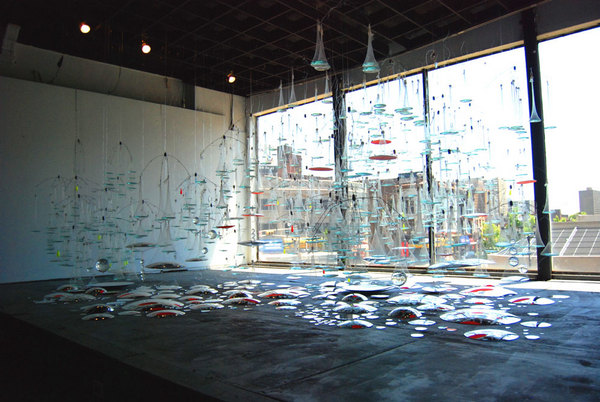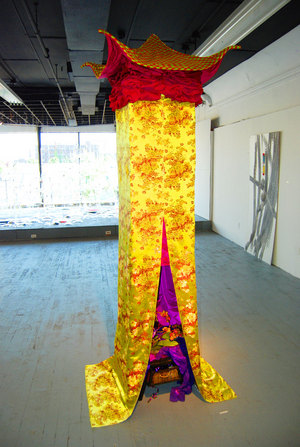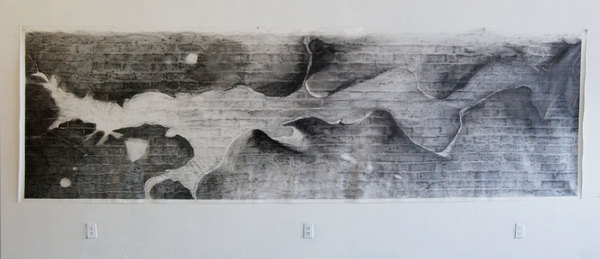This is an archive of the ArtCat Zine, 2007-2009. Please visit our new project, IDIOM.
Surfactant at Rupert Ravens
Surfactant - A Group Survey
Rupert Ravens Contemporary
85 Market Street, Second Floor, Newark, NJ
In Surfactant, as 17 artists chart immanent relationships amidst a stratum of novel material, surface tension waxes and wanes (a surfactant is a substance that reduces the surface tension of a liquid in which it is dissolved). In the midst of mining obfuscated properties embedded in the art terrain, the viewer is propelled into an intensive dialogue with the historical and metaphorical qualities of each of these works. Capped eloquently by Charles Baudelaire’s “On the Heroism of Modern Life” from Salon of 1846, “Absolute and eternal beauty does not exist, or rather it is only an abstraction creamed from the general surface,” therein divulging inner layers of the objects and installations presented.
With her triad of Asian-styled cylindrical structures, Gae Savannah takes on superficial fashion and “life of Girl.” These towering columns, housed in over-the-top fabric, embody the element of surprise. Topped with pagoda-like peaks, Savannah’s gangling tourelles contain tiny enclosures mimicking mini-boudoirs whose seduction is ultimately subverted by their reduced scale and inaccessibility. In Lu Shia, a plastic shower curtain wraps around its conical understructure while abbreviated details, such as a piece of lavish, quasi-fluorescent fabric, drape and tuck around an interior space like shining satin found in draperies in an Old Master painting, gone “Girl.” With combined references to the oriental and occidental, the ritualistic wrapping of fabric functions both inside and outside the structures, layering the work with cultural and metaphorical meaning. Not content to arouse the viewer with mere self-referentiality, these three regal beauties, in all their gleaming glitterati, strike a pose on a fictitious pop culture runway.
A slightly stricter take on materials, Shari Mendelson’s polycarbonate wall structure weaves intermittent clear, cloudy, and yellow disks that then radiate from the wall in a modular, airy form of relief. The vantage point here is highly democratic: moving from a frontal to a planar point of reference as interlocking plexi disks hover in optical space, a visual and physical interchange occurs, revealing in its ordered framework the impression of some type of molecular activity. An inner, ethereal light emanates from behind the edges of Mendelson’s mustered shapes extending visual energy outwards exponentially towards the viewer, casting this light in linear and planar trajectories. With subtle interplays of light, color and shadow demarcating overall form, the frontal view even plays on illusionism but with a literal stacked space.
Amplitude comes to mind when surveying Stephen Keltner’s steel and gold-plated glass wall constructions. Employing a sense of time through the initial reference to a frontal grid-like format, Keltner’s geometric forms then tilt self-consciously in deference to a receding space forming the semblance of a horizon line. Similar in energy to Mendelson’s piece, acute angles on either side of Richter 6 assert motion far beyond the confines of their respective endpoints, inducing a sense of infinite expansiveness. While coextensively retaining inner tension in relation to smaller grids that pull towards the center, the angles consign to the work a perpetual internal dynamic. These grids gone off kilter also possess a certain random, boldly whimsical quality about them in their varying shifts in degree, implying perspective space. Keltner’s structures angle slightly and slant, recede and protract, injecting his precise geometry with attitude, a modulated form imbued with a personality that recalls Mondrian’s Broadway Boogie-Woogie, but taken into a tango.
Surface reflection is evident en masse in Caroline Cox’s installation titled Scuse Me While I Kiss the Sky as shimmering spherical lenses and mirrors suspend from transparent nets in a borderless environment. Kindred to Mendelson’s plexi disks, Cox’s mirrored disks repeat and reflect, fissuring form and color so as to coax viewer perception into discerning what is visible from what is not. Cox’s lyrical assemblage gives one the impression of a fantasy garden - a hybridization of a semi-organic, semi-manmade pond, complete with illusory liquid pods. Much like Cox’s work, Shige Moriya’s diaphanous, swirling Floating Point augments the use of mirage through the employment of translucent fabric, water and light. Moriya also includes notions of time in Floating Point, however, as animated projections cyclically replicate his amorphous imagery.
In contrast to Cox and Moriya’s unrestricted treatment of material, J.G. Zimmerman harnesses his forms. On one wall he pairs two wing-like sculptures influenced by aviation, laying the groundwork for a relationship embedded in memory. One functions as a wire-frame x-ray; the other, in duplicate scale and silhouette, stretched in stark white canvas, operates as its end product. Though sparsely assembled in surface and skeletal construction, these objects decidely complement adjacent works through such shared concepts as time and completion.
The brick drawings of Gianluca Bianchino locate the viewer in a shallow planar surface, namely, “wall” space. This plane, implied by a graveyard-like rubbing of brick texture onto canvas, initially resists penetration, yet subsequently opens up as the eye starts to discern ambiguous space breaking through and affording it entry. In Wall Drift 1 geological descriptions of diverse shapes and sizes are instantly discerned and then effaced through the panoramic treatment and visual play of graphite on a hyper-expansive horizontal canvas, and, like Zimmerman’s prototypes, proffer sensations of topographical memory. The graphite creates varying degrees of chiaroscuro in the images, begetting an optical ride in and out of shallow, recessive, almost pliant space, affording the work a greater sense of illusion.
Somewhere between the open spaces of surface resides an ambiguous domain that allows us to scrutinize the linkages between materials and meaning. Through either more formal or more fluid aesthetic approaches, these artists work to dematerialize the material, prompting us to question the shifting relationship of time to the eternal, or of surface to substance, lending us a momentary glimpse inside matter.
ZINE
HOME
TIPS / COMMENTS
CATEGORIES
CONTRIBUTORS
- Greg Afinogenov
- B. Blagojevic
- Adda Birnir
- Susannah Edelbaum
- Julie Fishkin
- Paddy Johnson
- Jessica Loudis
- Christopher Reiger
- Andrew Robinson
- Peter J. Russo
- Blythe Sheldon
- S.C.Squibb
- Hrag Vartanian



